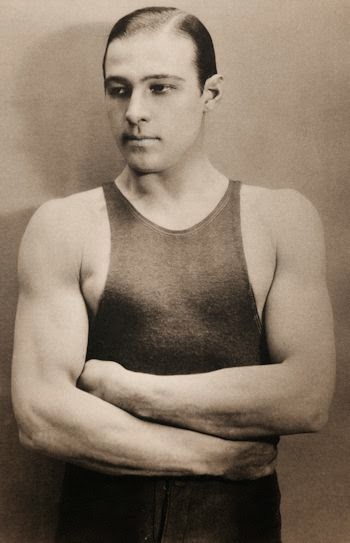Pordenone Diary - Day One Saturday October 5, 2024
 |
| Teatro Verdi |
Le Giornate del Cinema Muto in Pordenone is now a regular must-attend festival for me. I love traveling to Italy to be among some of the most knowledgeable, wonderful people and watching some of the most amazing films. Going to Pordenone is like returning home. Jay Weissberg and the entire crew of amazing people that run the festival feel like family. My friends who attend are also like family. The one good thing to come out of the pandemic that pushed me to finally make the trip in 2020.
Arriving and making my donation at the festival office, I
received my bag of swag and catalogue for the festival. Scanning the pocket
daily schedule, I learned we were in for a very full festival, indeed. In
addition to the early morning programs, e had late night screenings to consider.
One must pick and choose, mistakes will be made and sometimes thanks to jet-lag
and other maladies, decisions are made for you.
Saturday: October 5th
Starting off we had our first set of newly restored
Biograph short films from 1908. These are all part of The Biograph Project
helmed by Tracey Goessel of Film Preservation Society.* The goal of this 20
year project is to restore all of the extant Biograph short films directed by
D.W. Griffith. Each of the shorts presented this year derived from the extant
paper prints, no film elements are known to exist. I am not going to recap each
film and will mention the films that I particularly enjoyed.
The first film screened was, as far as I can recall, the
only 1908 Biograph I’d seen, The Adventures of Dollie. A theme of
kidnapped children seems to have been a regular feature at this time, not just
Griffith/Biograph films. Nonetheless, this was truly eye-opening because of the
quality of the film presented. As I mentioned above, each of these films were
scanned from the “paper prints” held by the Library of Congress (or Museum of
Modern Art) which had been scanned and the image quality on the big screen was
simply amazing. Arthur Johnson and Linda Arvidson (Mrs. Griffith) leapt off the
screen. As did the journey of the barrel containing the young Dollie meandering
down the river towards a perilous waterfall. This journey far less tense than
the later ice floe sequence in the 1920 film Way Down East.
The Redman and the Child featured
the unexpected turn of a civilized native American in the film. Sadly, not as
advanced as one might hope as the Indian is still subservient to the white man.
Nonetheless, the action moved swiftly and the rescue of the child and the
drowning of one of the nasty kidnappers was quite graphic.
Next program was the first of a series of actualities “Sicilia”
in which we get our first (of many) views of Palermo in Sicily. I do love
actualities because they are a window to the past. Do not ask me why, but, I
had no idea that Palermo was such a lovely and sophisticated capital. This
would not be the first time to see these locations, they will be sprinkled
throughout the week.
 |
| The 41st |
The first of the Canon Revisted programs is a Soviet film Sorok Pervyi/The Forty-First (1926) which was a total surprise for me. This film veered around widely from the Red Army sniper/sharpshooter Mascha played by Ada Voitsik who has notched 40 kills on the butt of her rifle. Missing the 41st target Lieutenant Govorukha-Otrok played by Ivan Koval-Samborsky she soon falls in love with him. After being sent on to the Reds headquarters via a captured boat, the story gets a little Robsinson Crusoe as the vessel capsizes and the land on an island. The Lieutenant christens Mascha as his “Man Friday” and the pair then fall in love in this island idyll. After some time together they spy a boat approaching the island, first thinking it is fishermen who will rescue them. It is shown they are White Army soldiers and the Lieutenant intends to join them. Realizing this, Mascha then completes her mission and kills him, her forty-first. My pathetic recap of the plot does not do justice to the film. I really loved it, found the story gripping and the performances raw and compelling.
I skipped Dinty as I have it at home, and plan to
watch it soon. This was the first of the films directed to the art direction of
Ben Carré. Dinner called instead.
 |
| The 3 Bad Men (Image: MoMA) |
The opening evening program was John Ford’s 3 Bad Men (1926) starring hunky favorite George O’Brien and Olive Borden. The best performances for me were the 3 bad men, Tom Santschi (Bull), J. Farrell MacDonald (Mike) and Frank Campeau (Spade). Of course, I cannot not mention the practically mustache twirling real villain Sheriff, Layne Hunter played by Lou Tellegen. The epic tale that was shot on location in Jackson Hole, Wyoming (Ford always had an eye for great locations), culminated in one of the most exciting depictions of the great land rush. Timothy Brock composed and conducted the score, performed by the excellent The Orchestra da Camera di Pordenone. (Spoiler) Each of the 3 Bad Men gave great and moving performances as they sacrificed their lives for the happiness of George O’Brien and Olive Borden.
 |
| 3 Bad Men (Valerio Greco Photography) |
Thus ended Day One.
Gelato count: 1
Apreol Spritz: 1


Comments